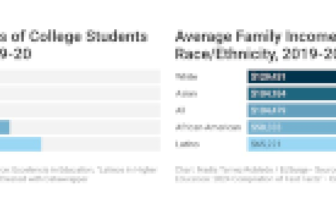Unlocking the Power of Creativity and AI: Preparing Students for the Future Workforce

[ad_1]
Teaching creativity and creative thinking in K-12 has always been valued but often challenging to implement. Many standards and curricula don’t call out creativity explicitly, and teachers aren’t often trained on how to teach and assess creative thinking. As such, many students enter college and the workforce not having enough practice in key critical thinking skills that they need to be innovative problem-solvers and effective communicators.
The past two years have witnessed a notable surge in the use of artificial intelligence within education, marked by increased investment, deployment and integration into various educational practices. This surge has prompted a growing exploration of AI’s potential to more easily bring creativity into the classroom, exemplified by the emergence of AI-powered tools capable of generating text, images, music and video with no coding necessary. However, amid this advancement, some educators new to teaching creative thinking wonder if creative AI will enable, or replace, students’creative thinking for students.
Recently, EdSurge webinar host Carl Hooker discussed with field experts about opportunities and challenges to fostering creativity in the classroom with AI, defining creative thinking beyond traditional artistic pursuits, addressing equity and ethical considerations, reimagining the role of teachers in the AI-enhanced classroom and helping students get jobs and careers that rely on creative and AI skills. Webinar panelists Stacie Johnson, leader of professional development at Khan Academy, Pat Yongpradit, chief academic officer at Code.org and leader of TeachAI, and Brian Johnsrud, global head of education learning and advocacy at Adobe, each offered unique and valuable perspectives on the intersection of AI and creativity.
EdSurge: Some people feel that being creative means being artistic and, therefore, claim to be “not creative.” How would you respond to that?
Johnsrud: The World Economic Forum this past year reported that creative thinking is the number-one skill needed across industries globally in the next five years. By creative thinking, they do not mean they need people who can draw and paint well. Instead, creative thinking is the ability to create and innovate something that has value. What that skill looks like is brainstorming lots of different ideas, evaluating those ideas, designing and iterating, getting feedback, collaborating and sharing ideas effectively. That end-to-end process is creative thinking.
How can we help educators overcome the fear of the unknown regarding AI?
Johnson: This is a new phenomenon, so we have to acknowledge the emotions and the feelings that come from that [fear]. One thing we can do to support teachers is make AI accessible in a practical way to educators, [making it as easy as] asking about what’s for dinner tonight or how I can plan my vacation. We need to do this before we try to apply it to the already overburdened, busy work schedule of educators, who need to experience the tool and build up their comfort. It falls on us as leaders and professionals to be committed to providing ongoing support and being a thought partner with the people on the front lines who bring AI to kids.
Yongpradit: I often get to engage with policymakers and education leaders, and I would say that the most helpful thing to do is to get them interacting with the tools in a relevant way, connecting to something they’re actually working on right now. If policymakers and education leaders can see how valuable the tools can be for [achieving] their existing goals, then they’re hooked and more open to having the AI conversations and passing on that support to all the school districts and teachers whom they serve.
What are the equity and ethical considerations when it comes to AI use?
Johnson: If we want to ensure equitable access, I want to really hammer home the point that teachers need training. AI isn’t just a new tool; it is a shift in pedagogy. Training a couple of times a year during these PD days is not enough. Teachers need strategies and thought partnerships. They need to feel empowered and have ongoing support to bring AI into the classroom in a developmentally appropriate way that is best for their students.
AI can bring access in a way that we’ve never had before. The challenge facing us right now is ensuring that this access gets to everyone without widening that digital divide. As industry leaders and educational leaders, we have to be really intentional about focusing on historically underrepresented communities and doing whatever we can to ensure that access starts there and that we’re empowering every community.
Yongpradit: The equity concern is more than the idea of a burgeoning AI divide in terms of access to the internet, devices and even the people who can teach students about this technology. Michael Trucano from the Brookings Institution commented that the divide we will see is where some kids get taught just by AI, and other kids get taught by AI plus a human, which is obviously way better.
Johnsrud: There are a lot of economic and career opportunities for students to have a very different future than their parents or grandparents did — if they have the assistance of AI. But if students have to learn about AI tools on their own because they don’t have access to them in the classroom, that’s an equity concern. It’s not that AI will take their job; it’s that someone using AI might get that job.
How will the role of a teacher evolve as AI becomes more prevalent in learning? Or are we overemphasizing the transformative nature of this tool?
Johnson: It will be transformative, but I would actually flip that question back to the teams developing this technology. As we design these technologies for schools and teachers, we should focus on addressing the problems faced by the teacher, learner, classroom, and school. We have a responsibility to really explore that to its fullest potential. AI can’t replace teachers; it lacks the human connection. Teachers inspire, mentor and understand students’ unique individual needs. AI can aid and empower teaching, which will be transformative, but it can’t replicate those human elements that really have an impact on students’ lives.
How can educators address the concern about students using AI to cheat?
Yongpradit: There is research out of Stanford that found that the prevalence of cheating overall remained the same with the introduction of ChatGPT. Basically, a cheater is going to cheat; ChatGPT is not pushing students to cheat. So, we need students to understand: Hey, you’re going to graduate and get a job, and you’re not going to be able to perform if you keep on cheating; you’re going to pay the price at some point.
Johnsrud: We have a lot of history of technology in the classroom that we can learn from. The fear when calculators were introduced in the math classroom wasn’t just that students were going to cheat; it was that the reliance on calculators was going to affect the development of their conceptual mathematical-thinking skills; by the time they got to calculus, maybe they wouldn’t be able to do conceptual math because they relied on calculators. That wasn’t the case. Using calculators increased mathematical thinking skills, but not just by themselves; there was a lot of really thoughtful pedagogy on when and how to introduce calculators.
For decades, this notion of authentic assessment has been on the table — this push to go beyond multiple choice with assessments that authentically evaluate what a student learns, how they learn and how they think. If it’s really easy for your students to cheat and get an A on your assessment, is that an authentic assessment? An authentic assessment should be hard to cheat on because a student has to bring so much of themselves to it that it’s kind of cheat-proof. I know that’s not always easy to do, but I like that AI is pushing this vision of authentic assessments forward a bit.
Johnson: We have an obligation to think about transforming traditional assignments into something more interactive and problem-solving-based. We can make little changes to how we assess student understanding and emphasize fostering critical and creative thinking so that students are deeply engaged and working through iteration.
We also have an opportunity as educators to redefine the line between what cheating is and what efficiency is. When we find ourselves waiting for ChatGPT to come back online to write an email or a proposal but don’t want our students to use that same sort of efficiency, we need to challenge our own thinking.
[ad_2]
Source link







